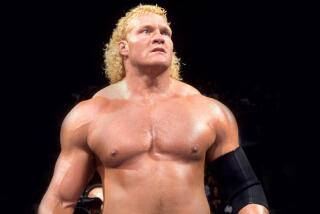David Shoemaker’s ‘The Squared Circle’ looks at wrestling’s heavy toll
In the rococo mid-’70s, my father and his three sons would gather around our black-and-white TV and watch World Wide Wrestling matches on Saturday afternoons. We were entranced by the long-running tag-team feud between “baby faces” — good guys — Chief Jay Strongbow (born Joseph Scarpa) and his partner Billy White Wolf, a.k.a Adnan Bin Abdulkareem Ahmed Alkaissy El Farthie (a high school chum of one Saddam Hussein), and “heels” — bad guys — Mr. Fuji and Professor Toru Tanaka, wizards of malice from the inscrutable Orient (both actually Hawaiians), whose diabolical tricks included throwing salt into opponents’ eyes. Wrestling brought a rare community to our troubled household.
When tom-toms began to pound off-screen we thrilled with the knowledge that the Chief would soon run down the aisle in his feathered headdress to finish his opponents with a signature “Tomahawk chop” or “Indian death lock.” My father grumbled “fake,” but I didn’t care: Nowhere else did good shine and evil sneer so clearly.
The code of wrestling, known as “kayfabe,” demands that the wrestler stay in character at all times, even outside the ring, that the illusions that sustain professional wrestling never be revealed to the public. In acid, engaging prose, Deadspin and Grantland writer David Shoemaker breaks kayfabe to document wrestling’s rhinestone squalor, above all, the damage inflicted on the human beings who serve as its plus-size avatars.
Sign up for our email newsletter, “Bookshelf”
“The Squared Circle” covers wrestling’s 20th century, from its sideshow days and slow racial integration to its mainstream crossover via Cyndi Lauper. Few events have been altered more than wrestling by media advances — television, cable, pay-per-view, Internet — and Shoemaker lucidly graphs the transformations.
Yet the book doesn’t shine until the Wrestlemania era of the 1980s. Having seen his first show in 1987 at age 9, Shoemaker watched the spectacle (a sport it is not) reach a bombastic apogee in the steroid era, when performers became comic-book superheroes. “Dead Wrestler of the Week,” the title of his Deadspin column, is in supreme bad taste, but it’s nothing less than documentary realism: Pro wrestlers were steroid lab rats who disintegrated as a result of the experiments conducted on their bodies and brains.
Although Shoemaker’s style emerged from the hipster snark of online journalism, his talent and the stakes transcend that genre. It really is a matter of life and death. In his introduction, Shoemaker writes that his goal is “to be fan first and a critic second.” He succeeds and fails — his enthusiasm is infectious, but the book raises questions that will complicate any fan’s relationship to a staged brutality that has deep roots in American culture.
Shoemaker incorporates his Deadspin columns into the text verbatim, wherein lies a problem. The same figure might be introduced two or three times, and the same observations, like those about wrestling’s evil genius, Vince McMahon, recur in slightly different forms. It’s like looking at the world through insect eyes. This disjunctive blur is reinforced by the sameness of the ring action. One wrestler taking the title via superplex from another fighter and in turn losing it in a steel-cage death match, then wins it again with a different organization via “mountain bomb.” “The Squared Circle” falls several drafts short of well done.
At times, it’s unclear whom Shoemaker is addressing — wrestling fans, pop culture aficionados, mainstream America? References to Roland Barthes and Philip K. Dick accompany astute meta-critical observations of the relationship between wrestling and larger cultural trends. However, the lapses into insider speak and hermetic discussions of alphabet soup leagues and players will stymie anyone not already an aficionado (despite a helpful, but limited glossary).
Half clown, half superhero, the wrestler is also a human being with a difficult job. World Wrestling Entertainment is a company town, with no union and brief careers. Like other athletes, the performers risk everything to reach the big time, including steroid cocktails, followed by booze and painkillers to dull the effect of working up to 300 nights a year. It’s estimated that professional wrestlers suffer brain injury at a level comparable to NFL linemen. The macabre title of Shoemaker’s Deadspin column takes on a disturbing resonance when the author confronts wrestling’s greatest tragedy.
On June 22, 2007, Chris Benoit, a.k.a. Wild Pegasus, Pegasus Kid and the Canadian Crippler, strangled his wife in their Fayetteville, Ga., mansion. Two days later, after dosing his 7-year-old son with Xanax, Benoit suffocated him. Bibles were left beside the bodies. The next day, Benoit hanged himself from the pulley of a weight machine. He was to have competed for a heavyweight title that night and had been sending disjointed text messages to his friends and employers. Shoemaker addresses this in a few pages that shift the entire register of the book.
An autopsy revealed that Benoit had the brain of an 85-year-old Alzheimer’s patient. He had been consuming enormous amounts of painkillers, steroids and testosterone, mostly via prescription. The drugs that created his superhuman physique took a toll, as did Benoit’s renown for letting his opponents strike to the back of his head at the brain stem.
In a move cruelly fitting for the mythical realm of professional wrestling, “his matches [were] scrubbed from DVD’s, his name largely whitewashed from the WWE record books, despite the fact he’s a five-time U.S. champion....” What happened to Benoit is, writ large, a version of the fates of wrestlers whose lives have ended too early via murder, suicide or physical collapse.
No story could ever encompass what took place with Chris Benoit and his family (which is where wrestling falls short of Greek tragedy) and kayfabe sealed Benoit’s mausoleum in darkness. Yet Shoemaker ensures that the most unsavory aspects of wrestling have their due and that the spectacle’s victims won’t be forgotten.
Anasi is the author of “The Last Bohemia” and “The Gloves.”
The Squared Circle
Life, Death, and Professional Wrestling
David Shoemaker a.k.a. “The Masked Man”
Gotham Books: 400 pp., $27
More to Read
Sign up for our Book Club newsletter
Get the latest news, events and more from the Los Angeles Times Book Club, and help us get L.A. reading and talking.
You may occasionally receive promotional content from the Los Angeles Times.









